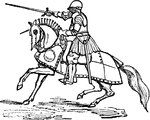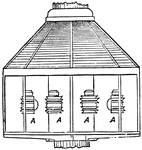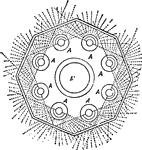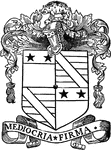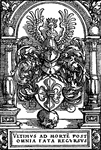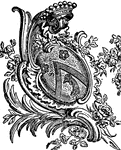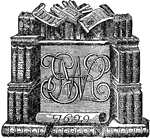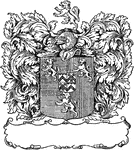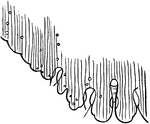
Fossil Echinidea
"Archaeocidaris Urii, Flem (spine and intermediate plate); Carboniferous, Ireland." — Encyclopedia…

Fossil Echinidea
"Cidaris florigemma, with spine, a, and single ambulacral plate, magnified, b, (after Wright; Coral…
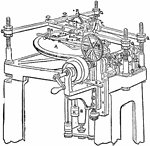
Dividing Engine
"The plate A is 46 inches in diameter, and is composed of gun metal. These were put on by original graduation,…

Helix Descrtorun
"Many species hibernate. The land-snails bury themselves in the ground, or conceal themselves under…
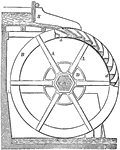
Water Wheel
"When a water fall ranges between 10 and 70 feet, and the water supply is from 3 to 25 cubic feet per…

Male Cockroach
"A genus of Orthopterous insects, having an oval or orbicular flattened body, the head hidden beneath…
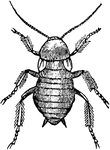
Female Cockroach
"A genus of Orthopterous insects, having an oval or orbicular flattened body, the head hidden beneath…

Astroides Calicularis
"Tangential section of a larva of Astroides calicularis which has fixed itself on a piece of cork. ec,…
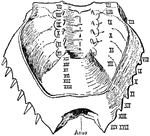
Limulus Polyphemus
"Ventral view of the posterior carapace or meso-metasomatic (opisthosomatic) fusion of Limulus polyphemus.…

Scorpion
"Ventral view of a scorpion. Palamnaeus indus, de Geer, to show the arrangement of the coxae of the…
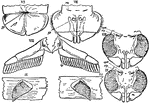
Mesosomatic
"The first three pairs of mesosomatic appendages of Scorpio and Limulus compared. VII. The genital operculum;…

Limulus Polyphemus
"View of the ventral surface of the mid-line of the prosomatic region of Limulus polyphemus. The coxae…
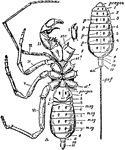
Thelyphonus
"Thelyphonus, one of the Pedipalpi. A, Ventral view. I, Chelicera (detached). II, Chelae. III, Palpiform…
Schizomus
"Schizomus crassicaudatus, a Tartarid Pedipalp. Dorsal view of a male with the appendages cut short.…

Liphistius Desultor
"Liphistus desultor, Ventral view with the prosomatic appendages cut short expecting the chelicerae…

Liphistius Desultor
"Liphistius desultor. Under side of the uplifted genital or first opisthosomatic somite of the female;…
Galeodes
"Galeodes sp., one of the solifugae. Dorsal view. I to VI, Bases of the prosomatic appendages. o, Eyes.…
Galeodes
"Galeodes sp., one of the Solifugae. I to VI, The six prosomatic limbs cut short. o, The eyes. b, c,…

Garypus Litoralis
"Garypus litoralis, one of the Pseudoscorpiones. Ventral view. I to VI, Prosomatic appendages. o, Sterno-coxal…
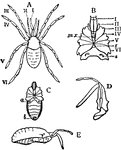
Stylocellus Sumatranus
"Stylocellus sumatranus, one of the Opiliones; after Thorell. Enlarged. A, Dorsal view; I to VI, the…
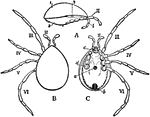
Holothyrus Nitidissimus
"Holothyrus nitidissimus, one of the Acari; ater Thorell. A, Lateral view with appendages III to VI…

Full Plate Armor
"Suit by Jacob Topf, nearly complete; the gorget does not belong to it." — The Encyclopedia Britannica,…

Bee Abdomen
"Abdominal Plate (worker of Apis), under side, third segment. W, wax-yielding surface, covering true…

Bicycle Chain
"The "roller" chain consists of a series of outside and inside links. The outside link A is made up…
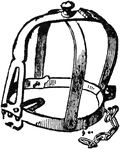
Brank
"Brank, or Branks, an instrument and formerly used in Scotland, and to some extent also in England,…

Brasses
"Sepulchral or monumental, large plates of brass inlaid in polished slabs of stone, and usually exhibiting…

Hotblast Stove
"The oldest form of blast heating apparatus, applied by Neilson, consisted of a tubular rivetted boiler…
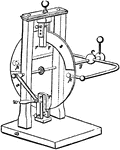
Electrical Machine
"The electrical machine most usually employed consists of a large circular plate of glass, mounted upon…
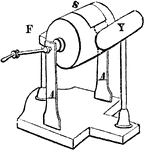
Electrical Machine
"A form of an electrical machine. S being the glass cylinder turning on an axis, Y the conductor, F…
Gold Plate
"It is of gold plate, so thick as to require no "piping" at the back to sustain it; but in general the…
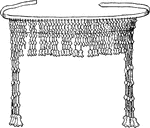
Diadem
"Diadems or head fillets of pure hammered gold cut into thin plates, attached to rings by double gold…

Floating Lights
"aa is the mast, b tackle hook, c, c brass flanges for fixing parts of lantern together, e and g weather…
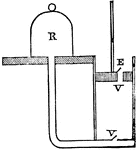
Air Pump
"The air pump is an engine by which the air can be pumped out of a vessel, or withdrawn from it. The…
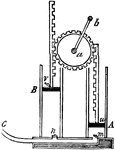
Air Pump
"The piston rods are furnished with racks, or teeth, and are worked by the toothed wheel a, which is…
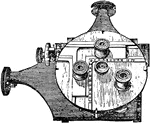
Micrometer
"A plate of glass about 2.5 inches square is ruled with twenty-one lines in one direction .1 inch apart,…

Heliometer
"Dollond's divided object-glass heliometer of the third type. A is the end of the reflecting telescope,…

Heliometer
"No part of the equatorial mounting is shown in the figure, as it resembles every respect that usual…
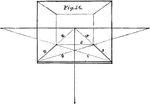
Parallel Perspective
The perspective shown in this plate is parallel perspective; and the subject here intended to be represented…

Angular Perspective
The perspective in this plate is "angular perspective," and the figure it represents is a flat square…
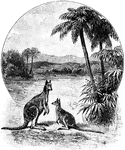
Australian Scenery
Australia's 7,686,850 square kilometers landmass is on the Indo-Australian Plate. Surrounded by Indian,…
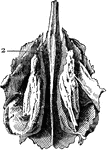
Ethmoid Bone of the Human Skull
Ethmoid bone, posterior surface. The ethmoid bone is an exceedingly light, spongy bone, placed between…
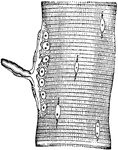
Nerve Ending in Muscle Fiber of Lizard
Nerve ending in muscular fiber of a lizard (Kühne). The end-plate, or motorial ending of the axone,…
Volta's Crown of Cups
"The metallic elements C and Z each conssted of two metals, the plate C being of copper and the plate…
